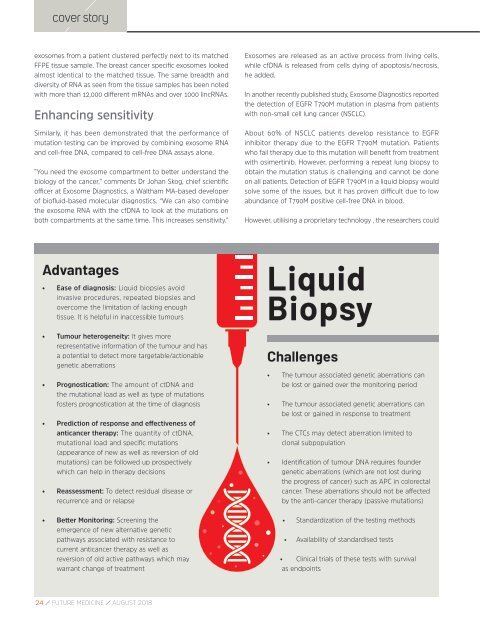FM AUGUST 2018 ISSUE1 - digital edition
You also want an ePaper? Increase the reach of your titles
YUMPU automatically turns print PDFs into web optimized ePapers that Google loves.
cover story<br />
exosomes from a patient clustered perfectly next to its matched<br />
FFPE tissue sample. The breast cancer specific exosomes looked<br />
almost identical to the matched tissue. The same breadth and<br />
diversity of RNA as seen from the tissue samples has been noted<br />
with more than 12,000 different mRNAs and over 1000 lincRNAs.<br />
Enhancing sensitivity<br />
Similarly, it has been demonstrated that the performance of<br />
mutation testing can be improved by combining exosome RNA<br />
and cell-free DNA, compared to cell-free DNA assays alone.<br />
”You need the exosome compartment to better understand the<br />
biology of the cancer,” comments Dr Johan Skog, chief scientific<br />
officer at Exosome Diagnostics, a Waltham MA-based developer<br />
of biofluid-based molecular diagnostics. “We can also combine<br />
the exosome RNA with the cfDNA to look at the mutations on<br />
both compartments at the same time. This increases sensitivity.”<br />
Exosomes are released as an active process from living cells,<br />
while cfDNA is released from cells dying of apoptosis/necrosis,<br />
he added.<br />
In another recently published study, Exosome Diagnostics reported<br />
the detection of EGFR T790M mutation in plasma from patients<br />
with non-small cell lung cancer (NSCLC).<br />
About 60% of NSCLC patients develop resistance to EGFR<br />
inhibitor therapy due to the EGFR T790M mutation. Patients<br />
who fail therapy due to this mutation will benefit from treatment<br />
with osimertinib. However, performing a repeat lung biopsy to<br />
obtain the mutation status is challenging and cannot be done<br />
on all patients. Detection of EGFR T790M in a liquid biopsy would<br />
solve some of the issues, but it has proven difficult due to low<br />
abundance of T790M positive cell-free DNA in blood.<br />
However, utiliising a proprietary technology , the researchers could<br />
Advantages<br />
• Ease of diagnosis: Liquid biopsies avoid<br />
invasive procedures, repeated biopsies and<br />
overcome the limitation of lacking enough<br />
tissue. It is helpful in inaccessible tumours<br />
• Tumour heterogeneity: It gives more<br />
representative information of the tumour and has<br />
a potential to detect more targetable/actionable<br />
genetic aberrations<br />
• Prognostication: The amount of ctDNA and<br />
the mutational load as well as type of mutations<br />
fosters prognostication at the time of diagnosis<br />
• Prediction of response and effectiveness of<br />
anticancer therapy: The quantity of ctDNA,<br />
mutational load and specific mutations<br />
(appearance of new as well as reversion of old<br />
mutations) can be followed up prospectively<br />
which can help in therapy decisions<br />
• Reassessment: To detect residual disease or<br />
recurrence and or relapse<br />
• Better Monitoring: Screening the<br />
emergence of new alternative genetic<br />
pathways associated with resistance to<br />
current anticancer therapy as well as<br />
reversion of old active pathways which may<br />
warrant change of treatment<br />
Liquid<br />
Biopsy<br />
Challenges<br />
• The tumour associated genetic aberrations can<br />
be lost or gained over the monitoring period<br />
• The tumour associated genetic aberrations can<br />
be lost or gained in response to treatment<br />
• The CTCs may detect aberration limited to<br />
clonal subpopulation<br />
• Identification of tumour DNA requires founder<br />
genetic aberrations (which are not lost during<br />
the progress of cancer) such as APC in colorectal<br />
cancer. These aberrations should not be affected<br />
by the anti-cancer therapy (passive mutations)<br />
• Standardization of the testing methods<br />
• Availability of standardised tests<br />
• Clinical trials of these tests with survival<br />
as endpoints<br />
24 / FUTURE MEDICINE / <strong>AUGUST</strong> <strong>2018</strong>


















